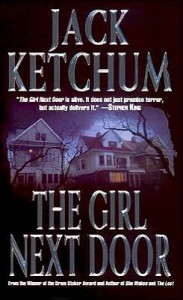Jack Ketchum’s The Girl Next Door
 The Girl Next Door
The Girl Next Door
by Jack Ketchum
Leisure Books, 2005
370 pages / Buy from Amazon
One principle guiding this year’s reading has been to delve more deeply into what’s filed under Horror. When people ask me what kind of stuff I write, I always struggle with that word, never quite sure what it’ll mean to them when I do or don’t use it. I like the word, and generally think of what I do as drawing from that side of things, but I’ve never 100% known, reading-wise, what it encompasses.
So this year I read some of the classics and tried to ground myself in the contemporary, English-language tradition of the genre: Stephen King (whose name has obviously loomed forever but whose work, aside from On Writing, I’d never really read), Thomas Ligotti (phenomenal, someone I hope to write about soon), Todd Grimson, Ramsey Campbell (cool in both senses of the word), Joe Hill (got a huge kick out of NOS4A2, though probably enough has been said about that book by now), Shirley Jackson, Dennis Etchison, Robert Shearman, Laird Barron, Bret Easton Ellis (crucial in his own way) … and Jack Ketchum.
Of everything I took in under these auspices, Ketchum’s The Girl Next Door hit me hardest. A few months later, it’s still in there, growing, helping me not forget that life’s a problem.
I could go on about its take on 60’s small-town American life and its amazingly apt and tender portrayal of boyhood and the loss of innocence and the rush of discovery when one’s own destructive urges first flare up, but what really tore this book into my lining was the surprising but inarguable way it distinguished the Banality of Evil (which everyone has) from something deeper, worse – call it the Uniqueness of Evil (which only some people have … or maybe they’re not even people at that point).
The premise, based loosely on a real crime committed in Indiana in 1965: a smart, hip NYC girl, Meg, and her disabled sister come to stay with their cousins and their freaky, bitter aunt in a New Jersey town after their parents are killed in a car crash. David, the narrator and boy next door, falls for Meg as soon as he meets her. Her worldliness, older-seeming-ness, the fact that she’s not a tiny-minded bigot … she doesn’t have to do much more than show up to introduce him to his “adolescence head-on.”
Things take their sweet, romantic time, all summery creekside flirtation and town funfairs, until Ruth, the sado-aunt, decides to imprison Meg in her bomb-shelter basement, claiming, in a fit of sanctimonious insanity, that she’s gonna teach the girl how not to be a slut and thereby spare her the grim fate of all women.
Thus the book enters its Banality of Evil phase, incrementally uncovering the dumb violence housed in Ruth’s sons and their neighborhood friends, David included: the way in which they all, horny and hopped-up on monster mags and hearsay, can’t resist the temptation of a hot girl chained and the freedom to lord themselves over her.
Under Ruth’s strict guidance, they torment the captive, dancing up to and back from the edge of sexual transgression, and torment themselves as well, wondering how far they’ll go, and how much it means to have an adult’s permission to go there … wondering whether going too far is inevitable or forbidden, and whether the deeper regret will prove to be doing or not doing the things they most want to do.
David hovers unstably between wanting to protect this girl he’s fallen for and wanting to relish the chance to see and touch her naked, to replace his normal teen fantasy with abnormal, unearned reality. “She was all I knew of sex,” he admits, “and all I knew of cruelty.”
Overcoming his initial revulsion and sense of wrongness, and thereby dismissing the only warning that could have saved Meg’s life because things are just getting started at this point, he stands by as “shame looked square in the face of desire and looked away again.”
All of this emotional development isn’t just the perfunctory “make the reader care about them so it’s scary when they get slaughtered” legwork. There’s something in David’s relationship to Meg and to the other, more easily unhinged boys, that rings absolutely true to the feeling of growing up and wanting to belong both to the species and to yourself, and to be one with your friends while also pursuing the things that take you away from them – both love and lust, doled out in equal parts tenderness and ferocity.
This whole Banality of Evil section is a masterpiece of denial and self-justification (and as good a Holocaust metaphor as I’ve seen), charting the ways in which David and the other boys combine permission and desire into a driving force that grossly trumps mercy. It’s as if the extremity of it all, the sense that it couldn’t be happening, excuses it, making it almost as though it isn’t happening, or at least promising that in retrospect, once they’ve had their fun and rite of passage, it won’t have happened for real.
January 13th, 2014 / 11:00 am
